This page contains affiliate links. We may earn money or products from the companies mentioned in this post through our independently chosen links, which earn us a commission. Learn More
The Blue Nose Pitbull is purebred American Pitbull Terrier, but it’s categorized by its nose color being blue. The Blue Pit is no different from other pit bulls, and it’s becoming popular among breeders, but it’s still rare to find. A Blue Nose Pitbull puppy can cost around $1,000 to $3,000.
The American Kennel Club has yet to recognize it. Nevertheless, pitbull non-enthusiasts balk at the idea of more Pitbulls roaming the world.





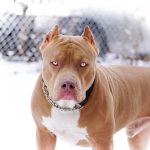



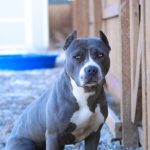
Images courtesy of FinestPitbullsMade Kennel
The myth, muck, and lore surrounding the Blue Nose Pitbull, and pitbulls in general, is difficult to wade through on your own. Let this comprehensive article be your guide in your quest to uncover the truth about the notorious Blue Nose Pitbull. Here are 9 things you should “nose” about the Blue Nose Pitbull:
Contents & Quick Navigation
#1 Why the Blue Nose?
Good question! The defining characteristic of a Blue Nose Pitbull is a rare blue-gray hue to the skin, eyes, nose, and toenails.
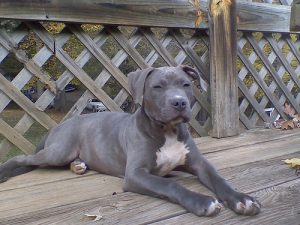 There are even Red Nose Pitbulls, whose skin, eyes, nose, and toenails have an amber tone. And no, these blue and red dogs don’t look like little stalky aliens or demons!
There are even Red Nose Pitbulls, whose skin, eyes, nose, and toenails have an amber tone. And no, these blue and red dogs don’t look like little stalky aliens or demons!
The striking blue or red coloring occurs when two parents with recessive coat-color genes breed, which doesn’t often happen naturally. After all, pitbulls with these recessive genes are rare, and it is even more unusual for two to cross the same doggie path!
These recessive genes trigger decreased melanin production. Melanin is the essential little bugger in the skin that determines skin color. In humans, it is responsible for tanning in the sun!
Because so many people prefer unique pitbull coloring, some breeders force recessive-gene pitbulls to breed together. If this sounds a little sketchy, it should. But more on this in #3.
For now, you should know that Blue Nose Pitbulls are not a separate breed. They are under the umbrella of American Pitbull Terriers, which are not recognized by the American Kennel Club.
In fact, Chauncy Bennet created the United Kennel Club (the second oldest dog registry organization in the U.S.) to register the excluded American Pitbull Terriers, who must have felt unofficial and sad.
#2 The Blue Nose Comes at a Price
Remember how I said that Blue Nose Pitbulls are rare because the recessive gene is uncommon? Well, this creates a dilemma for “backyard breeders” who want to cash in on blue lust.
How can they sell more and more Blue Nose Pitbulls if there is such a limited gene pool to begin with?
The unfortunate answer is that illegitimate breeders inhumanely inbreed their Blue Nose Pitbulls.
Sure, inbreeding generates money for the breeders in the short-term because initially, it is hard to tell if a dog is inbred–especially if the dog is young.
But inbreeding can create major long-term problems for the eventual owner because it leads to health problems such as immune disorders, cancer, grass allergy, heart disease, and cataracts.
Not only that, but because of their low melanin levels, Blue Nose Pitbulls are susceptible to immune and nervous system dysfunction, such as deafness, poor vision, skin spots, alopecia, and bad temperament.
In fact, because many breeders have a sole, driving focus of producing dogs with a blue coat and nose, they lose sight of the more crucial trait: an excellent temperament! Because of this, too many Blue Nose Pitbulls are born with aggressive or stubborn tendencies.
If you want a Blue Nose Pitbull as part of your family, be sure to get one from a reputable breeder!
#3 Beware of Breeding Scams and Fighting Circles
When it comes to uniquely colored pitbulls, scams are all over the place. Breeders advertise that Blue Nose Pitbulls are some special super dog with magical powers that it has used to find the elusive fountain of youth.
If this sounds a little far-fetched, that’s because it is. Sure, an individual Blue Nose Pitbull might be extra-special to its owner, but in general, a Blue Nose Pitbull is simply a pitbull.
Breeders jack up the price of Blue Nose Pitbulls, believing that blue lust will drive people to pay the unjust price. Some Blue Nose Pitbulls cost $3,000 or more!
Don’t pay such a high price. Approach a reputable breeder armed with the knowledge that the Blue Nose Pitbull is not some super dog–and pay accordingly.
Before choosing a breeder, be sure that the breeder is interested in the overall well-being of dogs. It is a sad fact that the pitbull fighting trade is still alive and well worldwide.
Do not support a breeder who takes advantage of the competitive spirit of dogs and forces them to fight one another. These fights are disheartening bloodbaths.
#4 (Try to) Understand the Complex Pitbull Lineage
If you are confused by all of the different types and terms associated with pitbulls, you aren’t the only one. A quick Google search reveals that even so-called experts don’t quite know what to make of pitbull lineage. But let’s try our best to dig into this.
There are three major breeds of pitbulls:
- American Pit Bull Terrier (APBT): recognized by American Dog Breeder’s Association and United Kennel Club
- American Staffordshire Terrier (AST): recognized by the American Kennel Club
- Staffordshire Bull Terrier (SBT): recognized by the American Kennel Club and United Kennel Club
All three types are working dogs with similar characteristics because they come from the same original ancestors. They belong to the terrier group and were originally bred for baiting bulls (unlike the American Bulldog, which is a member of the Mastiff group and was originally bred for hunting and guarding).
The Blue Nose Pitbull is a type of American Pit Bull Terrier, and it is considered more genetically-variable than the American Staffordshire Terrier.
For this reason, many people consider the AST to be the more consistent “show dog” version of the pitbull–and this is why the American Kennel Club recognizes the AST. (Among the first pitbulls registered with the AKC was Petey the Pup from The Little Rascals!)
Another reason that the American Kennel Club stays away from the APBT is that the term “pitbull” sparks controversy. In fact, each year, there are many calls for legislatures to ban pitbulls and other “aggressive” breeds.
That being said, pitbulls do have storied, blood-soaked history.
In the ancient Roman Empire, passionate spectators sat glued to their seats as they watched the ancestors of modern pitbulls maul each other to death. This tradition continued into the 1800s in Britain, where modern pitbulls originated.
So why is it so difficult to distinguish between the APBT, AST, and SBT? When breeders bred pitbulls for fighting, they did so in extreme isolation and secrecy, so that they wouldn’t reveal breeding secrets to their competitors.
#5 Don’t Judge a Book By its Cover
Sure, people initially took advantage of a pitbull’s gameness–or desire to compete–and turned it against other pitbulls. But this is not the defining feature of most modern pitbulls. Believe it or not, pitbulls are naturally gentle-hearted and kind-spirited.
Their muscle-bulging build and wide-set jaw might intimidate you at first, but after a few interactions with a pitbull sweetheart, you will be convinced.
Before the 1980s, the pitbull was actually a symbol of national strength and unity in the U.S. But some breeders ruined this when they decided that bigger is always better.
The weight of an average pitbull is between 30 and 50 pounds (14-23 kg), making it a medium-sized dog. But some breeders attempted to breed pitbulls to be upwards of 70 pounds! Because they were so focused on size, they neglected to consider temperament.
The result of this breeding travesty? The general public’s conception of the pitbull changed from a strong and courageous companion to a massive, blood-thirsty predator.
So what is the truth about a Blue Nose Pitbull’s temperament? In general, as with all dogs, puppies are easier to train than adults. If you are concerned about personality, stick to a puppy.
As long as you lovingly discipline, train, and socialize your Blue Nose Pitbull puppy, he will grow to be an agreeable, non-threatening companion for years to come.
In fact, temperament tests reveal that pitbulls often score near Golden Retrievers–a family favorite! Pitbulls are some of the most consistent, predictable dogs on the planet.
An aggressive, vicious pitbull is more often a reflection of the owner’s lack of attention than the pitbull’s natural temperament.
Check out this video of a well-trained Blue Nose Pitbull!
#6 This Jumping Jack Will Keep You On Your Toes
Although Blue Nose Pitbulls are gentle, they are strong, and they love to jump. And I’m not just talking about little bunny hops here and there. Pitbulls jump HIGH and OFTEN. They are so athletic that they can unintentionally cause quite a lot of damage.
To avoid household damage and frustration, be sure to exercise them as much as possible. Many pitbulls should not go to the dog park, as they are not a fan of other furry friends. But they would love to go to the park on a leash.
Without regular activity, this athletic working dog is bound to become frustrated, aggressive, lethargic, and overweight.
If your Blue Nose Pitbull is not getting enough exercise, he will let you know. Pitbull ownership is not for the weekend warrior; they need daily intense aerobic exercise.
#7 It’s Gettin’ Hot In Here …
Because pitbulls love to play, they sweat A LOT! Frequent bathtimes are a must, especially if your Pitbull lives indoors. And unless you live in a temperate climate, they should live indoors.
They do not have a thick, protective coat, so they become cold easily. In general, pitbulls have a tough time regulating body temperature.
So do your Blue Nose Pitbull a favor and keep him in the air conditioning–except when it’s time to go outside and play–and then give him a bath!
#8 Man’s Best Friend Prefers Man Over Pesky Pups
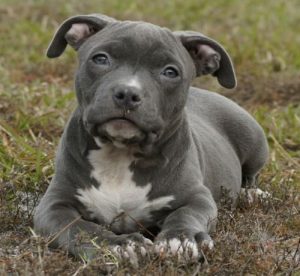 While each pitbull is different, this breed tends to prefer interactions with humans over other dogs. They can be trained from an early age to properly socialize with other dogs but still may gravitate toward humans–which is okay in my book!
While each pitbull is different, this breed tends to prefer interactions with humans over other dogs. They can be trained from an early age to properly socialize with other dogs but still may gravitate toward humans–which is okay in my book!
Older pitbulls that have already developed an aversion toward other dogs may never learn how to interact with other canines calmly.
In this case, when your Blue Nose Pitbull has to be around other dogs, use the crate and rotate method. That is, never let the dogs be together unsupervised; always keep one in the crate while the other roams free, and then switch it up.
The good news is that no matter how pitbulls react to other dogs, they tend to love humans! That’s right–they can distinguish between species. Never forget that your Blue Nose Pitbull is full of brawn and brains!
#9 It’s My Party and I Can Cry If I Want To
You may be surprised to learn that Blue Nosed Pitbulls are gentle with children and are also one of the most emotionally expressive dog breeds. They are more likely to play with an intruder than bark or growl at him, making them lousy watchdogs but lovely friends.
Be sure to take care of your Blue Nose Pitbulls emotional needs by spending enough quality time with him, showering him with love and attention, which he will excitedly lap up!
FAQs (Frequently Asked Questions)
🐕 What breed is a Blue Nose Pitbull?
The Blue Nose Pitbull is not a separate breed, but a type of American Pit Bull Terrier. And though they’re the same kind of dog, they have quite a few differences in terms of appearance that we mentioned here.
🐶 How can you tell if a Pitbull is a Blue Nose?
If you look at a Pit’s nose and it has a light black or grayish color, then you have a Blue Nose Pitbull. But aside from their sniffer, they have other distinct qualities that make them stand out from other Pitties. Those physical features are found in this section.
⚠️ Are Blue Nose Pitbulls more aggressive?
The term “pitbull” itself has negative connotations worldwide. But keep in mind that each dog is unique. Not one Pitbull is like the other. And these fur babies deserve so much more than get generalized. Do you really think that the color of a canine’s nose or their name is enough to affect their temperament?
👍 Are Blue Nose Pitbulls easy to train?
It’s common knowledge that teaching a puppy is way easier compared to an adult, no matter the breed. And before you can train any kind of dog and judge their skills or abilities, you have got to get to know what they’re like first.
💵 How much does a Blue Nose Pitbull puppy cost?
The price range of one Blue Nose Pitbull pup is about $1,000 to $3,000. It’s understandable that they’re rare but beware of scammers and irresponsible breeders who go after the blue lust.
So What’s the Verdict on Blue Nose Pitbulls?
Pitbulls, in general, are mired in controversy that seems to follow them no matter how well-behaved they are. First, there is the controversy of breeding.
Greedy “backyard breeders” inbreed within the tiny recessive gene pool to ensure that pitbulls have unique coloring and meet the “blue lust” demand. This leads to health and behavioral problems, but even so, they jack up the prices on these dogs, falsely advertising that they are an extra-special breed.
Most alarming, some of these breeders still participate in the blood-soaked pitbull fighting games that were common throughout history but have been banned for many years.
If you decide that a Blue Nose Pitbull is right for you, make sure that you choose a high-quality breeder.
While Blue Nose Pitbulls can be the most emotional, gentle, and kind dogs on the market today, human error has created an air of misconception and controversy around these lovable creatures. You can thoroughly research breeders and take your chances with a Blue Nose Pitbull, or you can choose an American Staffordshire Terrier, which is the “show dog” pitbull that has less variability in temperament and health.
Let the Debate Continue…
Whether you have a Blue Nose Pitbull or just want to participate in the on-going heated debate about pitbulls, I’d love to hear from you.
Is the pitbull a misunderstood affectionate creature or a blood-thirsty predator? You decide!








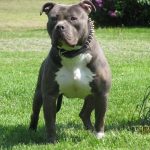

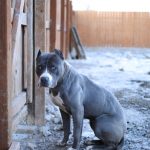
7 replies on “9 Things You Should “Nose” about the Blue Nose Pitbull”
Is every pit bull with a dark black/blue nose a Blue Nose?
Must they have a solid blue/Grey coat, or can they be piebald?
Everyone asks if my dogs a blue nose, but since they were back yard rescues I do not know and am very curious.
This was very helpful. I think I have a blue nose pit, He looks just like these in pic, altho I think Memphis is more handsome. My daughter found him. No collar, no chop. He is stubborn and a big baby, he’s scared of his own shadow. But love him anyway.
Thus far in my life I’ve owned two of the pit breeds. Both are full of licks and kisses. They were jealous, but not aggressively. They would get between me and what ever is getting attention. Female was easier to teach. The male would cooperate if food is involved. Female loved to fetch. Male is like, REALLY? Female would get beer for me out of the fridge, male, helped me drink it.
I’m also curious about our rescue doggie, she looks blue nose but has hazel eyes and quite small paws! How do we know if she’s mixed with another breed or full blue nose?
I’d your furbaby has a dark black nose, it’s not a blue nose. Blue nose pits have eyes, coats, nose, paw pads, and claws that are a blue gray color. This is due to the recessive gene that masks the black color.
I have a blue nose pit that my daughter picked out as a puppy. He was the only blue nose and the smallest of the litter. Good breeders and friends of hers, they were afraid he may not make it as the runt and also he was sickly but she wanted him anyway. She loves him too…but she got a job and moved, but he is my baby. That will be a year ago in December and he’s doing great. He does have a grass allergy and has a very tricky diet, but he’s the most intelligent, beautiful, loving doggy. He gets along great with other dogs cause we started him early socializing. He even gets along great with my two cats. And I’m proud of my bull terrier.
Hello Alexandra. My Co-worker has a Blue Nose pit. He was raised by her from a puppy and now is 3 years old. He is a big baby and loves his family and friends. There is a new baby born to the household and the pit licks his feet in friendship. She now has to give her pit up due to moving and no pets are allowed. Do you know of a safe and great place for pitbulls. Please ask around and let us know. We all have several dogs that we rescued already. We want a place for Max (the blue nose pit) that will love and play with him. Please help if you can.